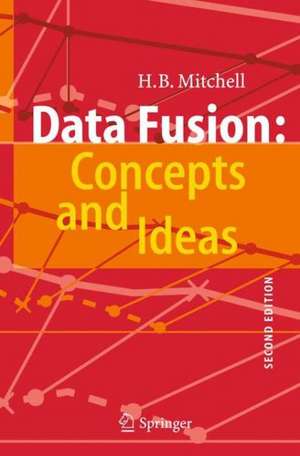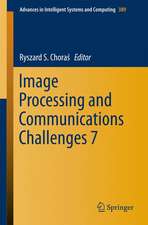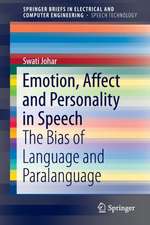Data Fusion: Concepts and Ideas
Autor H.B. Mitchellen Limba Engleză Paperback – 13 apr 2014
It is an extensively revised second edition of the author's successful book: "Multi-Sensor Data Fusion:
An Introduction" which was originally published by Springer-Verlag in 2007.
The main changes in the new book are:
New Material: Apart from one new chapter there are approximately 30 new sections, 50 new examples and 100 new references. At the same time, material which is out-of-date has been eliminated and the remaining text has been rewritten for added clarity. Altogether, the new book is nearly 70 pages
longer than the original book.
Matlab code: Where appropriate we have given details of Matlab code which may be downloaded from the worldwide web. In a few places, where such code is not readily available, we have included Matlab code in the body of the text.
Layout. The layout and typography has been revised. Examples and Matlab code now appear on a gray background for easy identification and advancd material is marked with an asterisk.
The book is intended to be self-contained. No previous knowledge of multi-sensor data fusion is assumed, although some familarity with the basic tools of linear algebra, calculus and simple probability is recommended.
Although conceptually simple, the study of mult-sensor data fusion presents challenges that are unique within the education of the electrical engineer or computer scientist. To become competent in the field the student must become familiar with tools taken from a wide range of diverse subjects
including: neural networks, signal processing, statistical estimation, tracking algorithms, computer vision and control theory. All too often, the student views multi-sensor data fusion as a miscellaneous assortment of different processes which bear no relationship to each other. In contrast, in this book the processes are unified by using a common statistical framework. As a consequence, the underlying pattern of relationships that exists between the different methodologies is made evident.
The book is illustrated with many real-life examples taken from a diverse range of applications and contains an extensive list of modern references.
| Toate formatele și edițiile | Preț | Express |
|---|---|---|
| Paperback (1) | 645.20 lei 6-8 săpt. | |
| Springer Berlin, Heidelberg – 13 apr 2014 | 645.20 lei 6-8 săpt. | |
| Hardback (1) | 650.77 lei 6-8 săpt. | |
| Springer Berlin, Heidelberg – 13 feb 2012 | 650.77 lei 6-8 săpt. |
Preț: 645.20 lei
Preț vechi: 759.07 lei
-15% Nou
Puncte Express: 968
Preț estimativ în valută:
123.46€ • 128.90$ • 102.18£
123.46€ • 128.90$ • 102.18£
Carte tipărită la comandă
Livrare economică 04-18 aprilie
Preluare comenzi: 021 569.72.76
Specificații
ISBN-13: 9783642437304
ISBN-10: 3642437303
Pagini: 360
Ilustrații: XIV, 346 p.
Dimensiuni: 155 x 235 x 22 mm
Greutate: 0.55 kg
Ediția:2nd ed. 2012
Editura: Springer Berlin, Heidelberg
Colecția Springer
Locul publicării:Berlin, Heidelberg, Germany
ISBN-10: 3642437303
Pagini: 360
Ilustrații: XIV, 346 p.
Dimensiuni: 155 x 235 x 22 mm
Greutate: 0.55 kg
Ediția:2nd ed. 2012
Editura: Springer Berlin, Heidelberg
Colecția Springer
Locul publicării:Berlin, Heidelberg, Germany
Public țintă
ResearchCuprins
Introduction.- Sensors.- Architecture.- Common Representational Format.- Spatial Alignment.- Temporal Alignment.- Semantic Alignment.- Radiometric Normalization.- Bayesian Inference.- Parameter Estimation.- Robust Statistics.- Sequential Bayesian Inference.- Bayesian Decision Theory.- Ensemble Learning.- Sensor Management.
Textul de pe ultima copertă
“Data Fusion: Concepts and Ideas” provides a comprehensive introduction to the concepts and idea of multisensor data fusion. This textbook is an extensively revised second edition of the author's successful book: "Multi-Sensor Data Fusion: An Introduction". The book is self-contained and no previous knowledge of multi-sensor data fusion is assumed. The reader is made familiar with tools taken from a wide range of diverse subjects including: neural networks, signal processing, statistical estimation, tracking algorithms, computer vision and control theory which are combined by using a common statistical framework. As a consequence, the underlying pattern of relationships that exists between the different methodologies is made evident. The book is illustrated with many real-life examples taken from a diverse range of applications and contains an extensive list of modern references. The new completely revised and updated edition includes nearly 70 pages of new material including a full new chapter as well as approximately 30 new sections, 50 new examples and 100 new references as well as additional Matlab code where appropriate.
Caracteristici
Comprehensive introduction to the concepts and idea of multisensor data fusion
Extensively revised second edition of the book: "Multi-Sensor Data Fusion: An Introduction"
Illustrated with many real-life examples taken from a diverse range of applications and contains an extensive list of modern references
Self-contained book, no previous knowledge of multi-sensor data fusion is assumed
Extensively revised second edition of the book: "Multi-Sensor Data Fusion: An Introduction"
Illustrated with many real-life examples taken from a diverse range of applications and contains an extensive list of modern references
Self-contained book, no previous knowledge of multi-sensor data fusion is assumed




















